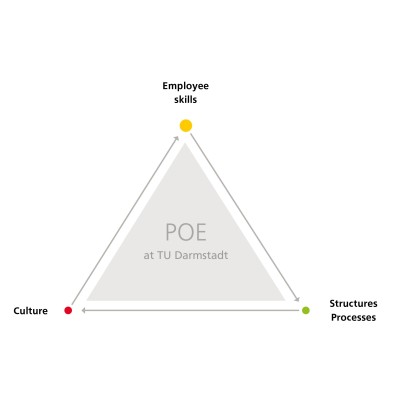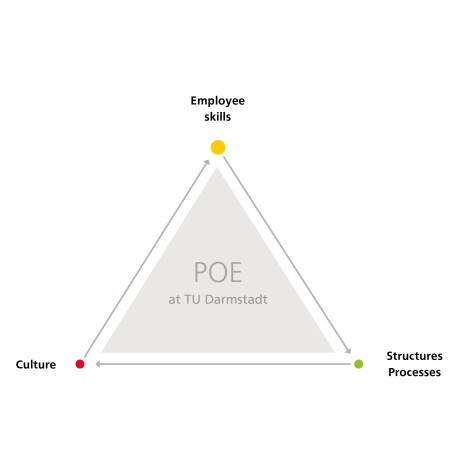The POE is fundamentally guided by developing the culture of togetherness as well as the competences and potentials of all employees, while at the same time advancing organisational structures and processes in such a way that they synergise with each other. The full document on our self-image can be found here.
Challenge – Staffing and recruitment
Job postings are sometimes extended again and again, applicants are “solicited”, so to speak, in order to be able to successfully fill a position. The core tasks of the university are research and teaching, but without a strong academic support system, research and teaching cannot realise their full potential. Shortages in this area are already noticeable at many universities. Depending on their location, universities compete with a large number of other organisations and companies for dedicated young talent. Especially the young generations of workers expect participation, development and a purpose in their work – the “what for and why” in their daily work in the organisation they work for.
Challenge – Digitalisation
Due to the continuous transformation processes through advancing digitalisation, we now find ourselves in an uncertain and constantly changing working environment. This fast pace requires increased attention and quick adaptability. The implementation of new, adapted processes and technologies makes a constant expansion of our existing skills and competences inevitable.
Challenge – Complexity
Other megatrends of our time such as globalisation, societal changes and demographic development also influence our working world and reshape both the economy and the academic world. All this adds up to a high degree of complexity in organisations and requires decisions to be made more and more frequently in a short period of time, taking into account a wide range of aspects and perspectives. Maintaining and expanding a team's own ability to act plays an increasingly decisive role in this.
A new approach to working together- Self-organisation
Strengthening self-organisation can be a way to respond to the growing complexity in everyday work described above. More self-organised forms of work aim to enable teams to make decisions together, to react in a more agile way and to make use of the “swarm intelligence” in the team. This is often accompanied by the concept of collegial leadership. Collegial leadership means that leadership work is distributed dynamically and decentrally instead of assigning this task exclusively to one leader centrally. The responsibility and processing of various leadership tasks is taken over by different people in the team. Teams working in this way are often dynamic and flexible because processes and tasks can be shared among many team members. Moreover, they are characterised by a high capacity to act, because even in complex situations they can make independent, timely decisions. These teams are used to the fact that tasks change between people, that processes are shaped together, reflected upon and sometimes have to be adjusted in a very timely manner so that all team members can fulfil their tasks in the best possible way. All this promotes joint growth as a team and the continuous optimisation of common processes and work results.
We in the POE unit have been working as a self-organised and collegially led team since 2021 and have hence taken a decisive step towards New Work. In concrete terms, this means that we make decisions together as a team and choose different functional roles (e.g. representative, moderator, clerk, etc.) for certain periods of time and fill them on a rotating basis. Leadership tasks are also shared within the team. General enquiries to the unit are forwarded by a representative to the entire team or the responsible colleagues, so that seamless communication from the outside to the unit as well as from the unit to the outside is ensured.
POE experiences – a self-report
The shift to a more self-organised way of working did of course not happen overnight. Rather, it was a constant process that was always challenging for us, but also allowed us to really experience the advantages of this form of work. An important part of the “agile mindset” is to simply try things out, experience them and then evaluate them – a very unfamiliar approach for us at first!
Challenges included for example the recurring, sometimes small-step coordination and joint decisions in the team, which were very time-consuming overall. But after some time, we developed a feeling for what needs coordination in the team and in which cases, if necessary, decisions can also be made directly by individuals. Keeping track of changing roles and responsibilities for different leadership tasks (“For what do I turn to whom?”) initially required some effort on our part. But here too, we established functioning and efficient support tools for us in our everyday work (e.g. task board, delegation matrix, context bridge, retrospectives and supervision).
The advantages of this way of working are that each team member knows more about the tasks of the others, that each of us takes on new responsibilities again and again and thus acquires new competences or can further develop the existing skills. Another advantage of this approach is the regular critical review of structures and processes. If something turned out to be less than optimal, we soon became much quicker at finding good and customised solutions for our team. It becomes natural to try things out, reflect on them and decide to continue doing them, to change/adapt them or to discard them again. This has established a new learning culture and thus also a culture of making mistakes, and we have become “faster and more agile” overall. New tasks and challenges can be tackled and realised more promptly. We are firmly convinced that this way of working will also help us to keep pace with the coming challenges of the world of work. The new possibilities for shaping the team, which were previously mostly reserved for the leader, result in more solidarity within the team and certainly also in greater satisfaction with one's own work. Overall, it has resulted in a noticeable development of our team members and the working style itself goes hand in hand with a continuous development of everyone. It should be understood in advance that such a transformation of the way of working requires backing from the higher-level manager, capacity, patience, courage and also willingness from all involved, but it can be worth it!



